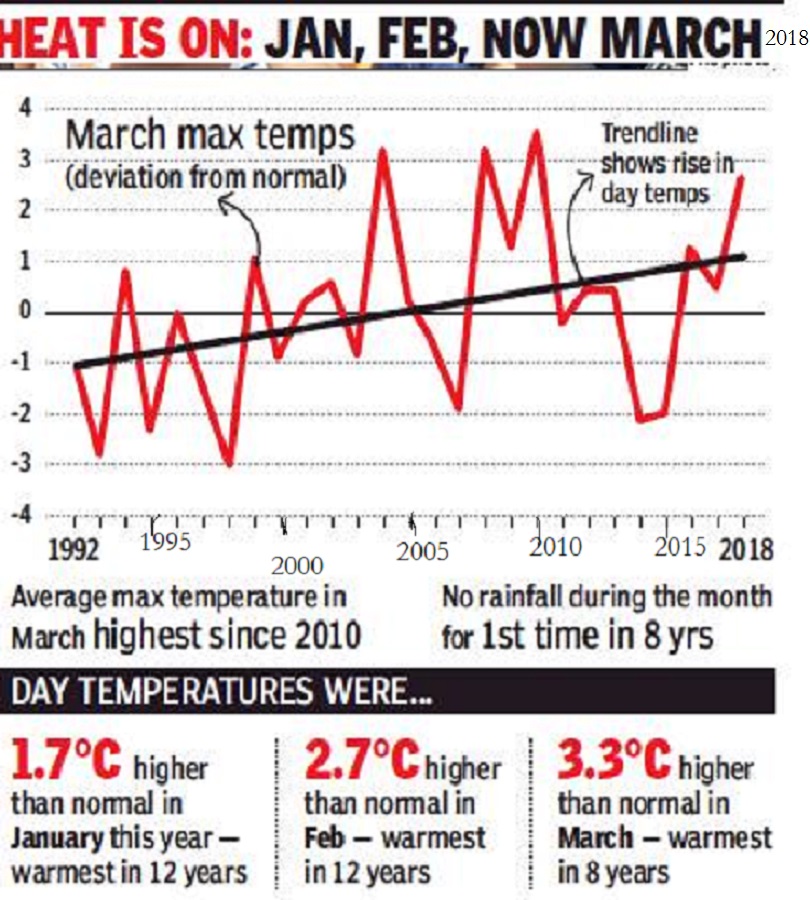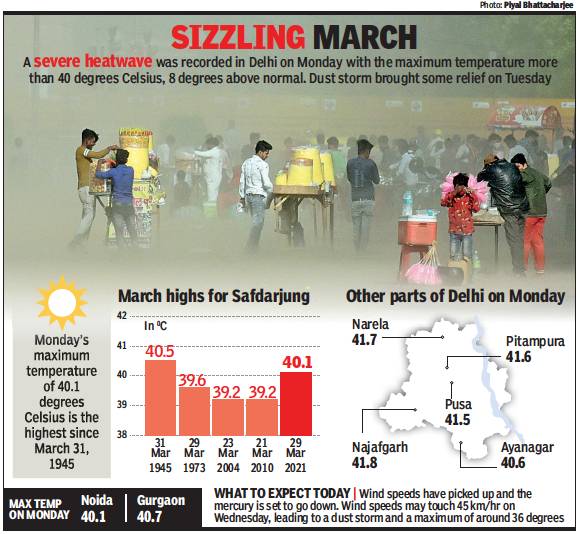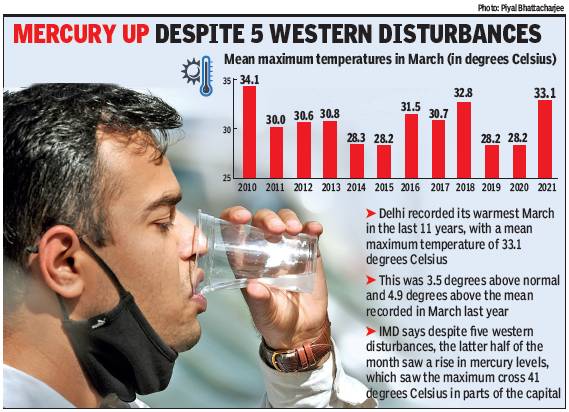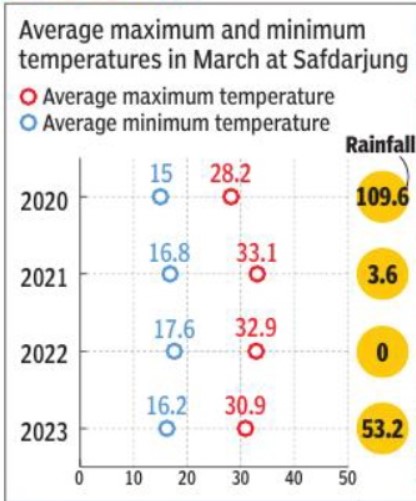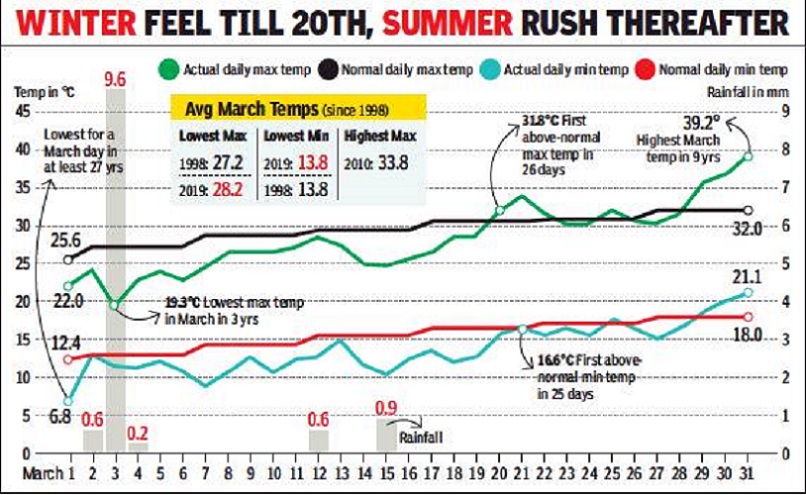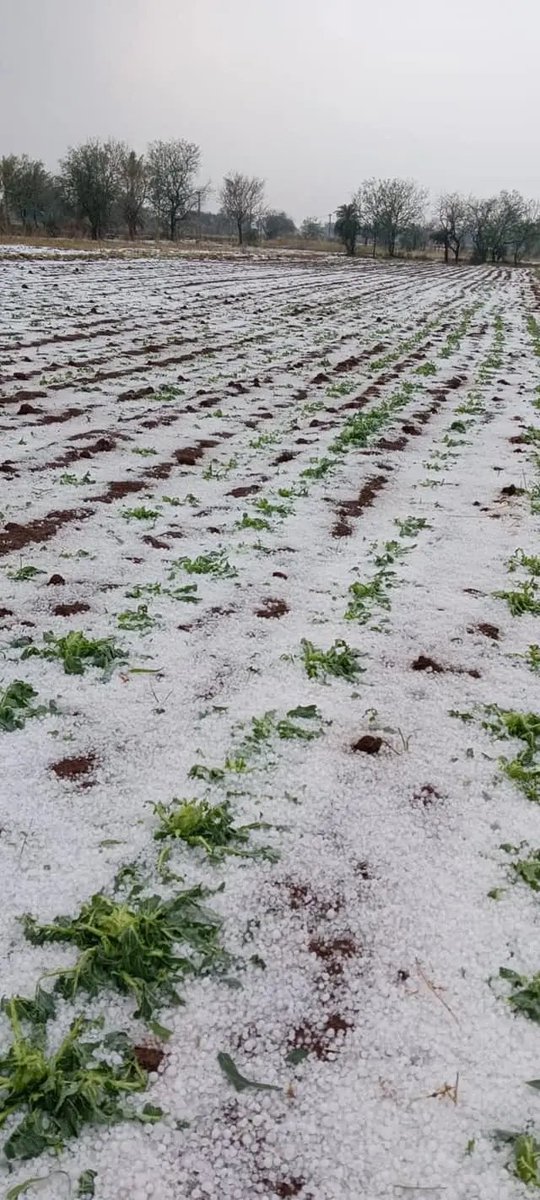March weather in India
DELHI’S WEATHER MIIRORS MUCH OF NORTH INDIA Readers are encouraged to send links to similar data about |
This is a collection of articles, mainly from the Delhi- based press. |
This page is under construction. Data will continue to be added over the next several years.
March as a whole
Typical weather
Express News Service | April 1, 2023
The pre-monsoon season from March to May is marked by thunderstorms, hailstorms, and squalls,
Monthly average maximum, minimum temperature
All- India: 1900-2022
March third warmest in 121 years: IMD | 05th April 2021 | PTI, Neha Madaan / TNN / Apr 2, 2022 and others
January and February 2021 were also the third and second warmest winter months in 121 years in terms of mean and minimum temperatures respectively, the IMD had said in its earlier report.
NEW DELHI: March 2021 was third warmest in 121 years in terms of monthly average maximum temperature, the India Meteorological Department on Monday said.
Monthly average maximum, minimum and mean temperature for the country as a whole during March
The normal for March
Average maximum temperature in India in March (the normal, based on 1981-2010): 31.24ºC
Average minimum temperature in India in March (the normal, based on 1981-2010): 18.87ºC
Average mean temperature in India in March (the normal, based on 1981-2010): 25.06ºC
March 2021: 32.65 degrees Celsius, 19.95 degrees Celsius and 26.30 degrees Celsius, respectively
March 2022
Average maximum temperature in India in March 2022: 33.1ºC
Average minimum temperature in India in March 2022: 20.24ºC
Average mean temperature in India in March 2022: 26.67ºC
2022 [In 2022], the average maximum temperature in March across the country and over northwest India was the highest from 1901.
Normal 31.24 degrees Celsius, 18.87 degrees Celsius and 25.06 degrees Celsius, respectively, based on the climatology period 1981-2010.
All India average monthly maximum temperature during March
Years with the warmest March, 1900-2022
2022 33. 1°C
2010 33.09 degrees Celsius
2004 32.82 degrees Celsius
2021 32.65 degrees Celsius
January and February 2021 were also the third and second warmest winter months in 121 years in terms of mean and minimum temperatures respectively, the IMD had said in its earlier report.
Several parts of the country had recorded temperatures above 40 degrees Celsius in March 2021.
The heat wave conditions at most places with "severe heat wave conditions" at isolated places occurred over west Rajasthan during March 29-31, 2021 the IMD said.
Heat wave conditions at a few places over east Rajasthan were also reported during March 30-31, 2021 over Odisha and adjoining parts of Gangetic west Bengal, coastal Andhra Pradesh, Tamil Nadu on March 31 2021.
"The highest maximum temperature of 44.6 degrees Celsius was recorded at Baripada (Odisha) on March 30, 2021 " the IMD said.
Mar 2021 also saw higher than normal as a total of seven Western Disturbances moved across the western Himalayan region against the normal of four Western Disturbances.
Dust raising Strong Surface Winds (SSW) prevailed during March 30-31 2021 over parts of Punjab, Rajasthan, Haryana, Chandigarh, Delhi, Uttar Pradesh, Madhya Pradesh and Strong Surface Winds (speed reaching 30-40 kilometres per hour) prevailed over Jharkhand and Gangetic West Bengal.
Delhi, 1951-2022
Priyangi Agarwal, April 1, 2022: The Times of India
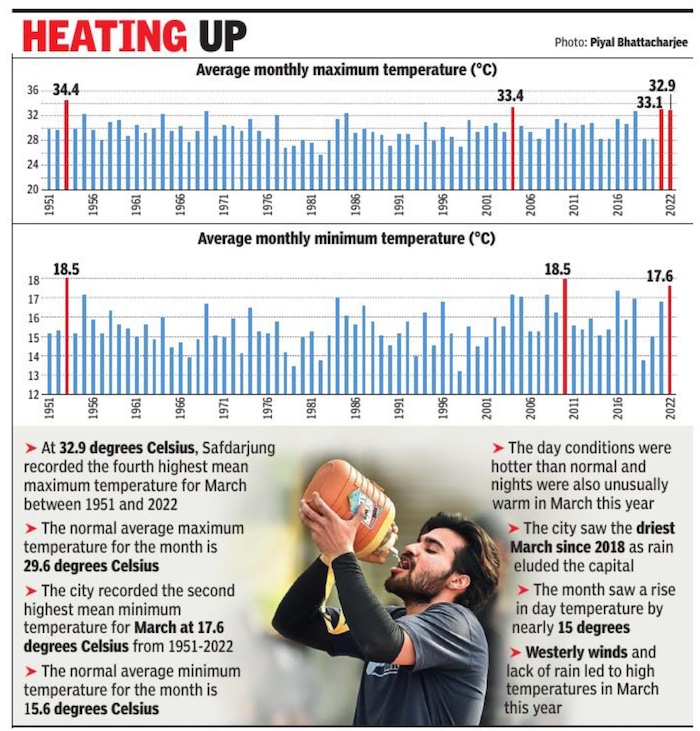
From: Priyangi Agarwal, April 1, 2022: The Times of India
New Delhi: Delhiites experienced a unique March this year. Safdarjung weather station logged a mean maximum temperature at 32. 9 degrees Celsius this March, the fourth highest in the past 72 years. Alongside, the mean minimum temperature was 17. 6 degrees Celsius, which is the second highest average minimum temperature for the month in the past 72 years. This means that both the days and nig hts in March 2022 were unusually warm. It was also the driest March in four years after rain eluded the capital throughout the month.
According to India Meteorological Department, the average monthly maximum temperature this March was 3. 3 degrees above normal. The highest mean maximum temperature ever recorded in March was in 1953 with 34. 4 degrees Celsius.
Similarly , the mean minimum temperature recorded in March this year was two degrees above normal. The highest ever average for the month in this regard came in 1953 and 2010 with 18. 5 degrees Celsius both the years. “This March saw warmer days and nights mostly due to long dry spells and absence of rain,” explained R K Jenamani, senior scientist at IMD. “On most days, dry and warm westerly winds from the desert area blew into the region, leading to a rise in temperatures. ”
Though the temperature in the first week remained below 30 degrees Celsius, it rose to n early 40 degrees Celsius by the last week of the month. On Wednesday, the maximum temperature soared to 39. 6 degrees Celsius, making it the second hottest March day in the past 72 years.
The IMD’s data shows that the maximum temperature, which was 25. 3 degrees Celsius on March 1, went beyond 39 degrees Celsius in the last week of the month. This means the mercury soared by nearly 15 degrees Celsius during the month. The day temperature crossed the 30-degree mark on March 7 and the temperatures remained above normal for the remaining days of the mo nth. The latter half of the month was hotter than normal as the day temperature hovered around 35 degrees Celsius after March 16, except on March 24. The maximum temperature, thus, was at least five degrees above the normal for this time in March. Similarly, the minimum temperatures remained above normal on most days of the month.
Met officials s aid three-fo- ur western disturbances normally impact the region in March, but n o active western disturbance affected DelhiNCR, leading to hot and dry weather. In comparison, there were two rainy days in March in 2020 and 10 such days in 2019. The dry spell also led to a deteriora tion in air quality. The Central Pollution Control Board’s data shows that the overall Air Quality Index remained in the ‘poor’ category on most days in the month.
The coolest Marches
Delhi
Mean minimum temperature
2019-24
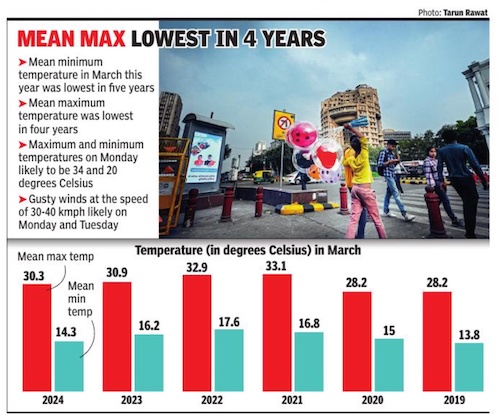
From: April 1, 2024: The Times of India
See graphic:
Mean minimum temperature in March in Delhi, 2019-24
The warmest Marches in...
Delhi, 1992-2018: March getting warmer
[Amit.Bhattacharya |Delhi feels the heat: Warmest March in 8 yrs @timesgroup.com The Times of India] 2018
New Delhi: Day temperatures in the capital have remained the highest in years for the third month in a row, with March setting an eightyear heat record as rains continued to remain elusive in the region.
The average maximum temperature during [March 2018] was 3.3 degrees Celsius higher than normal. Higher-than-normal day temperatures prevailed on 30 out of 31 days during the month while the normal minimums were breached on 26 days.
The data comes on the back of high day temperatures seen in January and February [2018]. Both months were the warmest seen in the capital in 12 years. With this, all three months of the year have been unusually warm in Delhi. With IMD forecasting a sizzling summer ahead for the region, heat records could well keep tumbling.
March getting warmer every year, reveal data
The average maximum temperature of 32.9 degrees Celsius during March 2018 the month was the highest since 2010, when it had reached 33.8 degrees C. Data since 1992 reveal that maximum temperatures in March have been steadily rising, a trend that could be linked to global warming.
The hottest March days in...
Delhi
1945-2021: Highest maximum temperatures
The highest maximum temperature recorded in March at Safdarjung, 1945-2021
40.6 °C at Palam 28th March 2018
40.5 °C March 31, 1945
40.1 °C March 30, 2021
39.6 °C March 29, 1973
39.2 degrees Celsius March ? 2019
39.2 °C March ? 2010
38.8 degrees Celsius March ? 2017
38.6° Celsius [at Safdarjang] March ? 2018, the highest maximum temperature of the month,
38.3 °C in March 2017, the highest maximum temperature of the month
And then, some random ‘high’ temperatures
37.3 degrees Celsius 2021 Mar 28, 2021
34.2 degrees Celsius: March 9, 2021
34 degrees Celsius: third week of March 2019
33.9 degrees Celsius: 4 March 2021
33.3 degrees Celsius: 26 March, 2020, the highest maximum temperature of the month was as low as this
1999- 2018
See graphic, '1999- 2018: The hottest March days in Delhi'
Jammu
1945-2022
37.3 degree Celsius 2022 March 27
37.2 degrees Celsius 1945 March 31
Mumbai
Hail
2006, March 9, Mumbai reported its first-ever hail.
2023, March 6/ 7: locals in parts of MMR, like Gorai, reported hail The second in recorded history
Highest maximum temperature
41.6oC on March 17, 2011: The all-time high day temperature recorded in March
Rain
2023, March 6/ 7: Some areas recorded light rain. IMD said the rainfall was largely a drizzle and couldn't reach measuring levels. IMD officials said this kind of rainfall is not abnormal as March is known as a pre-monsoon period.
Mean temperatures in March
Delhi/ Maximum
2010-21
March 2021 was city’s warmest in 11 years | Jasjeev.Gandhiok@timesgroup.com
A month after recording its second-warmest February in 120 years, the capital endured its warmest March since 2010. The mean maximum temperature was at 33.1°C — 3.5°C above normal; the figure was at 34.1°C 11 years ago, according to the India Meteorological Department (IMD).
Despite as many as five western disturbances and a bit of rain, its latter half saw the mercury rise sharply, crossing 41°C in many parts of the city on 29 Mar — the warmest March day since 1945.
The maximum was below 30°C on just four days of the month, whereas the maximum temperature for the first half of March normally swings between 25°C and 29°C, Kuldeep Srivastava, a scientist at the IMD and head of the Regional Weather Forecasting Centre (RWFC) in the city, said.
Spells of western disturbances brought some relief, but there wasn’t significant rainfall to bring the mercury down for a sustained period.
Delhi had earlier recorded its second warmest February in the last 120 years with a mean maximum temperature of 27.9 degrees Celsius, eclipsed only by 2006, when the mean maximum temperature was 29.7 degrees. The mean maximum was four degrees above normal in February.
Delhi/ Average maximum and minimum temperatures
2020- 2023
See graphic ‘Average maximum and minimum temperatures in Delhi, 2020- 2023’
Coldest Marches
Delhi, north India
2019 coldest March since 1998
Despite a sharp rise in temperatures in the last few days, Delhiites enjoyed the coolest March weather in 21 years as winter persisted well into the month this year with the mercury staying below normal till the 20th.
The mean maximum temperature during the month was 28.2 degrees Celsius, 1.4 degrees below normal, as per the met department’s recordings at Safdarjung. The last time Delhi had a lower mean maximum in March was in 1998 (27.9 degrees Celsius). The mean maximum in March 2015 was the same as this year.
The minimum temperature trends were even more unusual. At 13.8 degrees C, the mean minimum temperature during the month was 1.8 degrees below normal. It was the lowest recorded in March in at least 28 years for which met records were readily available, although in 1998 the mean minimum was the same as this year.
Monthly mean temperatures provide a snapshot of weather conditions during a period and are calculated by averaging the daily maximum and minimum temperatures during the month.
March in Delhi, and much of north India, is usually a month of transition when winter gives way to summer, with a brief spring thrown in. The transition this year was quite rapid. Temperatures remained consistently below normal till a couple of days before Holi (March 21), when the maximum breached the normal mark for the first time in 26 days. On Holi, the minimum rose above normal, again for the first time in 25 days.
Interestingly, the transition took place around the spring equinox (March 21 in Delhi), when the sun crosses over into the northern hemisphere, along with a rise in solar heat.
“Winter persisted for a longer period in north India mainly due to continuing snowfall in the hills. In the first half of March, western disturbances (WDs) were usually impacting the hill states but not the plains. These brought some snow and rain in the mountains, which kept the northern plains cool through northerly wind flows,” said B P Yadav, head of IMD’s Regional Meteorological Centre.
Yadav says the pattern changed in the last 10 days of March. “There were three back-to-back WDs during this period that also impacted the plains. Although Delhi-NCR didn’t get much rain during these disturbances, the wind flows changed to southerly and southwesterly. These are warmer winds that had an immediate effect on the region. In cool conditions, advent of heat raises temperatures sharply,” the official said.
The month began with the lowest temperature (6.8 degrees Celsius) recorded in March in at least 27 years. It ended with the warmest March day (39.2 degrees Celsius) in the capital since 2010. The contrast couldn’t have been sharper.
Rainfall during the month of March was 14.1mm, slightly below normal (15.9mm).
Lowest minimum temperatures in March
6.8 degrees Celsius/ 2019 March 1
8.8 degrees Celsius, 2024 March 7/ four degrees below normal.
9 degrees Celsius, 2024 March 5/ four degrees below normal.
9.5 degrees Celsius/ 2024 March 4, four degrees below normal
9.6 °C/ 2022
10 °C/ 2020
11.8 °C/ 2021
Lowest maximum temperatures in March
21.3 degrees Celsius, 2020 March 8
23.4 degrees Celsius, 2024 March 5/ four notches below normal
Mumbai
Lowest day temperatures in March
31.6 degree Celsius: 2023, Mar 18/ Santacruz observatory/ two degree Celsius below normal and also the lowest day temperature in 2021, 2022 or 2023.
31.7 degree Celsius (year not available but indicates the range): The previous lowest day temperature recorded in the city in March.
Lowest minimum temperatures in March
17.9 degrees Celsius/ 2020
18 degrees Celsius/ 2024 March 5; Santacruz; two degrees below normal
West Bengal
2019: coldest March since 2009
Due to high pressure over the Bay of Bengal, Kolkata experienced its first Nor’wester of the season, sharply bringing the temperature down in March. Thus, the city is experiencing its coldest days and nights in March over the last decade, according to the Kolkata meteorological centre.
The early half of February saw humidity in the air. This had led to record rainfall in and around Kolkata, according to weather reports.
The city saw a record minimum temperature of 15.5 degrees Celsius. The closest to this temperature was in 2011, when the mercury plummeted to 15.7 deg C in March.
Siliguri saw the mercury dipping to 9.8 degrees, Purulia 11.4 and Sriniketan 11.8 respectively.
Hailstorms
All India
2023
Express News Service | April 1, 2023
March 2023: From 14 to 21, there was large-scale hailstorm activity across the country.
Himachal Pradesh and Uttarakhand have recorded seven to 11 hailstorm days in March, 2023
Punjab, Haryana, Chandigarh, and Delhi saw one to three hailstorm days in March 2023
Vikarabad, Telangana
2023: ‘It’s not Switzerland'
17 Mar 2023 In a very rare weather occurrence, Vikarabad district in Telangana saw a heavy hailstorm strong enough to blanket the town in white. Roads turned white. People of Mominpet and Marpalle in the district posted tweets such as, ‘It’s not Switzerland. #Hailstorm lashes at Marpalle in Vikarabad dist, Telangana.’ It was reported that the hailstorm had led to extensive crop damage in the region, especially to maize, mango, papaya and green gram. Many of these crops were already at the ripening stages.
Rainfall
Definitions
The IMD classifies rainfall between 15.5m to 64.4mm in a single day as ‘moderate’ and more than 64.5mm as ‘heavy’.
All India
India
Express News Service | April 1, 2023
62.6 mm rainfall in 1967: the highest in the country since 1901.
37.6 mm in March 2023 is ranked 27th highest in the country since 1901
Central India
48.9 mm : March 1944 recordedthe highest amount of rainfall over Central India.
In 2023 Central India received the 11th highest amount of rainfall
The data shows that 100 weather stations reported heavy rainfall in March [In 2023], the highest since 2018.
In 2022, only 13 stations reported heavy rainfall in March.
2023 Most parts of the country recorded excess rain in [March 2023], and as a whole, the country recorded 37.6 mm, which is 26 per cent over the normal or long period average of 29.9 mm for the month.
The largest excess of 206 per cent of rainfall was recorded over Central India, while northwest India, due to deficits in Himachal Pradesh and Jammu and Kashmir and Ladakh, recorded 41.1 mm of rainfall, which is 14 per cent below the normal of 47.9 mm.
Chandigarh received 253% extra rainfall March 2023
Average
14. 8mm: normal average rainfall for March
17. 4mm: normal rainfall in March [1]
Delhi
Records for March/ 1992-2020
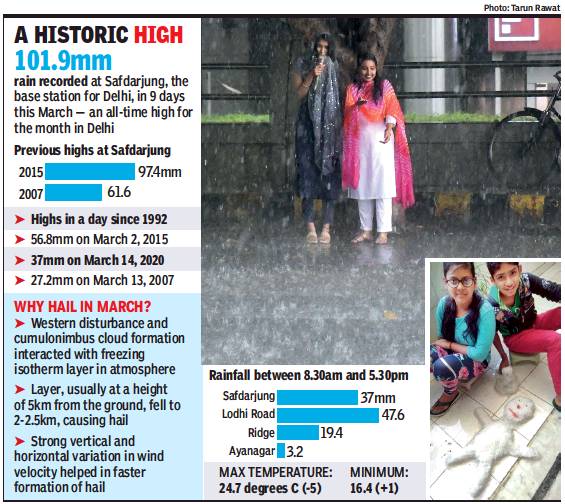
From: March 15, 2020: The Times of India
See graphic:
Months and days on which Delhi experienced its highest rainfall between 1992 and 14 March 2020.
2020 was the city’s wettest March ever with 101.9mm of rainfall recorded this month [till 14 March], beating the record set in March 2015 when 97.4mm of rainfall was recorded.
“The March 2020 western disturbance had been influencing north-west India since the night of March 10,” said Srivastava, adding that there had been nine rainy days in March [till 14 March].
During Feb to May decrease in the freezing level height is normally between 4km and 5km during this time of year but on Saturday it was between 2km to 2.5 km which resulted in hailstorm” added Srivastava. “By March 18 maximum temperature is expected to reach 30 degrees Celsius” he added.
2010-18
Another trend that continued from the previous months was below-normal rainfall. March saw zero rain for the first time since 2010 (although trace rain was recorded on March 21 2018).
“The warm days were a result of lack of moisture and practically no clouds during the period. An anti-cyclonic wind pattern set in during the last week that further ramped up temperatures,” said Kuldeep Srivastava, head of IMD’s Regional Weather Forecasting Centre.
Clear sky conditions during March 2018 also meant that nights remained cooler than normal. “Surface heat gets quickly dispersed into the atmosphere under cloudless conditions, leading to cool nights,” said Srivastava.
Delhi normally gets around 16mm of rainfall during March. In 2015, the city received 97.2mm of rain which was the highest ever for the month. Lack of rain during March this year also follows the trend of the past three months, with the entire northern region facing a massive rain and snowfall deficit for the period.
2020 rains: crops damaged
Unseasonal rains and hailstorms have, so far, affected rabi (winter sown) crops on 4 lakh hectares of land in north India with UP the worst-hit till Saturday. Besides UP, a few districts of Punjab, Haryana and Rajasthan too have borne the impact
Though the exact extent of damage is still unclear, officials in the agriculture ministry said preliminary reports from the ground suggest losses of up to 90% for vegetables, 70% for mustard and up to 60% for wheat and potatoes in certain districts in north-west India. Muzaffar nagar, Mathura, Ghaziabad, Gautam Budh Nagar and Aligarh are among the 31 districts which faced heavy damage in western UP.
No rainfall in the…
…first fortnight
2018, there was no rain in the month of March
2022: no rain in the first two weeks of March; zero in the whole of March 2022
2020-23
109. 6 mm: 2020 The Times of India
53. 2mm 2023
3. 6 mm: 2021
0: no rains in March 2022
Thunderstorms
2023
Express News Service | April 1, 2023
The second half of the month of March 2023 saw “unusual long spells” of thunderstorm activities over large parts of the country, according to the IMD.
1st March
Gurgaon 6°C, Delhi 6.8°C mn, coldest March in 20 years/ 2019
6.8°C: Coldest March day in 20 years; wet weekend likely | The Times of India
Cold wave conditions continued in the capital for the second day, with the minimum temperature on Friday remaining six notches below normal at 6.8 degrees C, making it the coldest day in March in at least 20 years for which The Times of India scanned weather records.
It was even colder in Gurgaon, where 6 degrees C was recorded.
In Delhi, Jafarpur and Mungeshpur recorded 6.4 degrees Celsius.
North India has been experiencing more western disturbances than normal for this time of the year. “The temperatures are extremely low for this time of the season and at their lowest for at least the past 20 years,” said a senior Met official.
Delhi’s maximum, too, was recorded below normal at 24.1 degrees Celsius — three notches below the normal. Relative humidity oscillated between 36% and 97%, an official said.
The high moisture content in the air led to deterioration of Delhi’s air quality into the ‘poor’ category again, according to Central Pollution Control Board readings.
2nd March
Delhi, 19°C, lowest mx in March/ 2015
2015 the maximum had fallen to 19°C on March 2.
Delhi, 56.8mm rainfall, a record: 2015
The highest spell of rain in a single day in March since 1992 It was on March 2, 2015 that Delhi had recorded 56.8mm rain in a day —.
March 2, 2015: it had rained 56.8 mm in the national capital.
Delhi, 19.3°C mx/ 2019
Rain, hailstorm likely to make it a wet Sunday
TIMES NEWS NETWORK
An overcast sky and light showers made the day temperature plummet to 19.3°C, eight notches below the normal for this time of the season. It was also the lowest maximum temperature recorded in March since 2015
3rd March
Delhi, 22.7°C mx, 11.5°C mn, 9.6mm rain/ 2019
Chill remains, rain cleans up city air TIMES NEWS NETWORK
The maximum temperature on Sunday reached 22.7° Celsius, four notches below the normal, while the minimum temperature was recorded at 11.5, two degree Celsius below the normal.
The city received light showers till 8.30am on Sunday with 9.6mm rain being recorded. Till 5.30pm since then, 0.2mm rain was recorded.
4th March
Delhi, fog (50m RVR) diverts, delays flights, trains/ 2019
11 flights diverted as fog in March stumps travellers | The Times of India
Owing to low visibility, several flyers were stranded at Delhi’s Indira Gandhi International Airport on Monday, as flights were delayed and many diverted to nearby airports due to fog. Rail operations too were hit, with trains running 1-2 hours late in the early hours. Officials at the airport said that the low visibility procedures were implemented at 5.28am and is still on.
According to officials, 10 domestic airlines and one international flight had to be diverted and over 100 flights were delayed by many hours. .
Ten flights were diverted from Delhi airport in the morning due to fog, an airport official said. “These flights were diverted between 7.45am and 9.45am,” the official said. A minimum runway visual range (RVR) of 50metre is required for a flight to land safely, however, it needs to be CAT III-B compliant. The minimum RVR for take-off is 125m.
Railway officials, meanwhile, said trains were slowed down due to low visibility.
5th March
Delhi, 22.8mx, 12°C mn, fog delays 100 flights, some trains/ 2019
The maximum and minimum temperatures on Tuesday were 22.8 degrees Celsius, four notches below normal, and 12 degrees Celsius, one point below normal, respectively.
The fog in Delhi is going to stay for some time. On Tuesday again, more than 100 flights were delayed and five were diverted to nearby locations. Operation of trains was affected as well. An airport official said that “there has been low visibility due to fog since 6.31am on Tuesday. Five flights have been diverted till 8.20am.”
Mumbai, 2023
38.1oC Mumbai
6th March
Delhi, 4.4°C mn/ 1945
The city’s all-time low (for March) is 4.4 degrees Celsius on March 6, 1945.
Delhi, 20.4 mm rain, 22.4°C/ 14°C: 2020
City sees highest 24-hour rainfall for March in 5 yrs
Western Disturbance To Blame; Another Spell On March 10
TIMES NEWS NETWORK
New Delhi:
Delhi on 6 Mar 2020 recorded its highest 24-hour rainfall in the month of March since 2015. India Meteorological Department (IMD) said that the Safdarjung observatory, which provided representative figures for Delhi, recorded 20.4 mm rainfall till 8.30am.
The weather station at south Delhi’s Palam logged 15.3mm rainfall, Lodhi Road 20.6mm, Ayanagar 19.1mm and the Ridge station 18.6mm.
Meanwhile, the rain that lashed the national capital overnight and also on 6 Mar afternoon brought the mercury down. Till 5.30pm, Safdarjung recorded 16.8mm rainfall, Palam 22.3mm, Lodhi Road 17.8mm, Ridge 24.8mm and Ayanagar recorded 17.2mm rain.
On Friday, the capital recorded a minimum temperature of 14 degrees Celsius, one notch above normal. The maximum temperature was 22.4 degree Celsius, six notches below the normal.
“There was moderate rainfall both overnight as well as in the afternoon. It was also a windy day with an average wind speed of 30-35 km per hour and gusty spells up to 50km per hour. Another western disturbance is also coming on March 10 and drizzle is expected in the night. On March 11 and 12, light rain is expected,” a Met official said.
The strong winds and overnight rain also helped the pollution levels in the city stay in the satisfactory level as the 24-hour average air quality index (AQI) clocked 64, a marginal improvement from 5 March’s 79, as per the Central Pollution Control Board (CPCB)’s 4pm bulletin.
Rabi crops severely hit
Unseasonal rains severely hit rabi crops TIMES NEWS NETWORK
New Delhi:
Unseasonal rains and hailstorms on Friday damaged standing rabi crops (mainly mustard and wheat) in many districts of Haryana, Punjab, Rajasthan and UP. Reports suggested that many farmerssuffered over 50% damage to their standing crops as heavy rains and hailstorm covered vast stretches from Jodhpur to Jammu and from Sikar to Varanasi.
“The rains, specifically hailstorm, caused extensive damage of wheat, mustard, gram, vegetable. The initial estimate of damage is 40% in wheat, 55% in mustard and 50% in vegetable. The worst-affected districts are Rohtak, Sikar, Aligarh, Agra, Shamli and Lucknow,” said Lucknowbased farm expert Sudhir Panwar.
Mumbai, 33.7°C mx, 21.6°C mn, 2018
With easterly winds continuing to bring in warm air and the sea breeze setting in late, maximum temperatures remained above normal on Tuesday. Weathermen said temperatures will rise further on Wednesday.
On Tuesday, the IMD Santacruz observatory saw a maximum temperature of 33.7 degrees Celsius, 0.9 degrees above normal, and a minimum of 21.6 degrees Celsius, 1.8 degrees above normal, which the IMD Colaba observatory recorded a maximum temperature of 31.4 degrees Celsius, 0.2 degrees above normal, and a minimum of 24 degrees Celsius, 2.4 degrees above normal. Humidity at Colaba and Santacruz was 66% and 35%. TNN
Mumbai 2023: the highest temperature in India
39.3 °C Santacruz. the highest temperatures in any part of the country on that day,. The high temperatures were followed by thunder and lightning at night which continued till early the next morning, bringing down the next day's maximum temperature to 35.8o Celsius. 6 March’s dust storm delayed arrivals into Mumbai airport,
7th March
2021/ Delhi
35.7 degrees Celsius at Najafgarh,
34.6 degrees Celsius at Jafarpur
34.4 degrees Celsius at Ayanagar and Pitampura.
34 degrees Celsius: at Safdarjung;
The minimum temperature at Safdarjung was 14.4 degrees Celsius.
8th March
9th March
10th March
11th March
Delhi, 28.4°C mx, 12.4°C mn, 0.6mm rain, 2019
Rain over 2 days may bring down temperature The Times of India
Strong showers lashed parts of the capital in th evening, bringing down mercury by several notches as air quality remained in the “moderate” category on CPCB’s index.
According to officials from the regional met department, parts of northern India saw light rain due to an active western disturbance,
Delhi recorded a maximum of 28.4 degrees Celsius on Monday — one degree below normal. The minimum was recorded at 12.4 degrees Celsius — two notches below normal for this time of the season. Till 8.30pm on Monday, Safdarjung station had recorded 0.6mm of rainfall, while Palam had received 0.3mm of rain in the same period.
12th March
13th March
14th March
Delhi, 24.6°C/ 11.8°C; 0.8mm rainfall; humidity 54>98%/ 2019
Temp drops after rain; air poor |TIMES NEWS NETWORK| The Times of India
Light showers on Thursday evening led to a drop in both the maximum and minimum temperature.
Delhi’s maximum temperature was recorded at 24.6 degrees Celsius — five notches below normal for this time of the season. The minimum, too, remained below normal and was recorded at 11.8 degrees Celsius. According to officials from the regional Met department, the capital recorded 0.8mm of rainfall between 8.30am to 5.30pm with the humidity levels oscillating between 54 and 98 percent in the last 24 hours.
“Palam, Lodhi Road, Ridge and Ayanagar stations all recorded very light rain during the day. Temperatures have dropped due to the showers.,” the official added.
Delhi, 37mm of rainfall, 24.7°C mx/ 2020
March 15, 2020: The Times of India
Weekend rain & hail make it city’s wettest March ever
2nd Highest Spell In One Day Of March In 28 Yrs
TIMES NEWS NETWORK
New Delhi:
Delhi was battered by rain and a hailstorm on 14th afternoon which left major roads waterlogged and slowed down traffic. The showers stretched across the city for over two hours, but lasted barely halfan-hour at one place. Such was the intensity that 37mm of rainfall of rain was recorded at the Safdarjung weather station in barely an hour, the second highest spell of rain in a single day in March since 1992. It was on March 2, 2015 that Delhi had recorded more rain in a day — 56.8mm.
Delhi’s maximum temperature was 24.7 degrees celsius on Saturday, five degrees below normal.
According to the IMD, most parts of Delhi, besides Noida and Greater Noida, experienced a spell of hail.
Srivastava said the hailstorm was caused due a reduction in the height of the freezing layer of the atmosphere, which with vertical wind shear led to easy formation of hail. “The freezing layer, where temperature is 0 degrees Celsius, is generally at a height of 4-5 km during this time of the year. It, however, fell to around 2-2.5km during this spell of western disturbance spell. The closer it is to the ground, more the chances of hail reaching the surface. Strong vertical and horizontal winds only aided the process,” said Srivastava.
While Delhi’s base observatory, Safdarjung, received 37mm of rainfall between 8.30 pm and 5.30 pm, Lodhi Road recorded even more during this period — 47.6mm. The Ridge and Ayanagar stations received 19.6mm and 3.2mm of rainfall, respectively. Palam, meanwhile, received just 0.4mm of rainfall with airport officials saying there was little to no impact of the rain on flight operations.
Meanwhile, the twin cities of Noida and Ghaziabad too received rainfall accompanied by hailstorm at number of places on 14th afternoon. According of IMD official the area received highest rainfall in March, which is a record with Safdarjung recording 101.9 mm rainfall. Western Disturbance created cyclonic circulation in the NCR resulting in rainfall.
Hailstorm hit number of places in Noida and Greater Noida and at scatter places in Ghaziabad bringing temperature down. “
15th March
Delhi: 25.8°C/ 10.4°C; humidity 49%> 93%; 0.9mm rain/ 2019
Showers clear air, Met says it may get very warm by Holi|TIMES NEWS NETWORK | The Times of India
Light showers were recorded on Thursday. Delhi recorded 0.9mm of rain until 8.30am as both minimum and maximum temperatures fell.
Delhi’s minimum temperature on Friday was recorded at 10.4 degrees Celsius — five notches below normal, while the maximum temperature was recorded at 25.8 degrees Celsius — three degrees below normal. The humidity levels, meanwhile, oscillated between 49% and 93%.
16th March
Delhi, 26.4°C/ 12.5°C; humidity 44>95%/ 2019
Mercury up, to clock 30°C by Holi | The Times of India
Warm weather may well and truly be here Delhi recorded a maximum of 26.4 degrees Celsius on Saturday — three notches below normal for this time of the season.
Delhi recorded a minimum of 12.5 degrees Celsius on Saturday, while the humidity levels oscillated from 44 to 95%.
17th March
18th March
Kerala (Pathanamthitta, Kozhikode, Malappuram): First ever sunburn outbreak in March/ 2019
Samayam Malayalam | Sunburn cases reported across Kerala as temperatures rise - Times of India
As the mercury kept rising, at least 58 people suffered sunburns across various districts in the state.
Most cases were reported from Pathanamthitta, Kozhikode and Malappuram districts.
This is the first time such high number of sunstroke cases have been reported from the state in the month of March.
19 people have reportedly been hospitalised in Pathanamthitta district in the last few weeks while 17 are having treatment in Kozhikode while Malappuram has recorded 13 such cases.
Health department has warned people not to engage in physical labour between 11 am and 3 pm.
19th March
Delhi/ 31.8 C mx, 12.8°C mn/ 2019
Safdarjung, the city’s main weather station, recorded a high of 31.8 degrees C on Tuesday, one notch above normal. This was the first time since February 21 that the temperature crossed the normal for the day — underscoring just how mild the month of March has been in the capital so far. “The rise in day temperatures is in association with an approaching western disturbance,” said B P Yadav, head of IMD’s Regional Meteorological Centre in the capital. The minimum on Tuesday was 12.8 degrees C, a good four notches below normal.
20th March
Delhi, light rain: 2018
New Delhi: The capital saw light rain on 20 March night, which saw the mercury levels drop by a couple of degrees. Delhi’s,
Delhi, 34.1°C, 2019
The season’s highest temperature so far: 34.1 degrees Celsius,
21st March
Delhi, 33.2°C mx, humidity 27 >72 %, 2018
2018: Delhi maximum temperature was around 33.2 degrees Celsius on Wednesday The Safdarjung observatory recorded “traces” of rain overnight (20/ 21 March), while similar activity was observed across parts of south Delhi. The city’s humidity, meanwhile, oscillated between 27 and 72 percent on Wednesday.
22nd March
Delhi, 39.2°C, abnormally hot, 2010
2010, the maximum touched 39.2 degrees Celsius on March 22.
23rd March
24th March
Kerala, high temperatures 40.2°C , sunstroke, water shortage/ 2019
Kerala: Mercury soars, IMD issues temperature alert for 2 more days | Mar 25, 2019 Times of India
The maximum temperature was the highest in Palakkad (40.2 degrees Celsius) and Punalur (38) on Sunday. The temperature was relatively high across the state on the day, with three suspected sunstroke cases reported. There is also a steady rise in the number of sunburn cases reported.
“Wind pattern and pressure are factors determining the temperature. Rain could have reduced the temperature,” an official said. Two men sustained sunburns in separate incidents in Alappuzha on Sunday.
KWA seeks police protection for reservoirs
Kerala Water Authority (KWA) has sought police protection for seven check dams fearing theft of water and unauthorized fishing in Palakkad. The structures are seven comprehensive drinking water sources of more than two lakh people in Chittur, Palakkad and Alathur taluks.
In a letter to district collector, KWA executive engineer R Jayachandran requested for regular police posts at Kunnamkattupathy regulatorcum-reservoir, Aryampallam, Thottupalam, Anajam Mayil, Kannadi, Thirunellai and Njavalinkadavu check dams in view of precarious water situation. A section of farmers was pumping stored water to irrigate coconuts plantations, it said. “There were incidents of anti-social elements releasing water from reservoirs for facilitating fishing activities using chemicals,” read the letter.
Delhi, 33°C/ 18.6°C, rain. winds/ 2020
Rain surprises city, more likely over next few days, Mach 25, 2020: The Times of India
New Delhi:
Gusty winds ranging from 30-40 km per hour, accompanied by a spell of light rain struck the capital on Tuesday evening, bringing down the mercury by several notches. Till 5.30pm, while Safdarjung recorded 0.6mm rain, Palam saw 2.1mm, Lodhi Road 1mm and Ayanagar 1.4mm.
Met officials said a western disturbance is influencing parts of north-west India,. The maximum temperature on Tuesday was 33 degrees Celsius, two notches above normal, while the minimum was 18.6 degrees Celsius, a notch below normal.
25th March
Delhi, mx under 30°C, mn 17.6°C, humidity 35> 79%, 2019
Temperature may touch 36°C by Friday | The Times of India
A brief drop in mercury with the maximum temperature touching 30 degrees Celsius on MondayThe capital saw strong surface winds with isolated parts recording light rain during the day, as maximum temperature settled at 30.4 degrees Celsius. Parts of Delhi saw a trace of rainfall Delhi’s minimum temperature, meanwhile, was recorded at 17.6 degrees Celsius — one degree above normal for this time of the season, with relative humidity oscillating between 35% and 79%. Officials said the city had an increase in moisture content, strong surface winds kept the air quality in the ‘moderate’ category.
26th March
27th March
28th March
Delhi, 40.6°C, hottest March day in 8 years/ 2018
2018: 40.6°C on hottest March day in 8 yrs
Relief Of 2-3 Days Likely But Temperatures Set To Rise Thereafter: Met Dept
TIMES NEWS NETWORK
New Delhi: In line with expectations of an early and hot summer, temperatures in the capital soared to an eightyear high for the month of March on Wednesday, with the mercury hitting 40 degrees Celsius for the first time in the season at Palam.
The day’s maximum temperature at Palam was 40.6 degrees C while Safdarjung recorded 38.6 degrees. Both were the highest recorded March temperatures at the respective stations since 2010. The readings were as much as eight degrees above normal at Palam and seven at Safdarjung.
Officials from the Regional Weather Forecasting Centre (RWFC) in Delhi said the temperature rise over the last few days has been due to clear skies and a reduction in wind speeds, further aided by anti-cyclonic dry winds from Rajasthan.
“The maximum is currently around 7 degrees above normal for this time of the season, mainly due to a reduction in wind speed over the last few days and clear skies. Delhi is seeing anti-cyclonic winds at the lower level from Rajasthan which is then turning towards UP through Delhi,” said Kuldeep Srivastava, scientist at RWFC.
Stations across the city recorded similarly high temperatures on Wednesday, with the mercury touching 39.9 degrees at Ridge and 39.2 at Ayanagar.
Delhi/ 2021
2021 Mar 28
39.6 degrees Celsius Narela
39.2 degrees Celsius Najafgarh
38.9 degrees Celsius Sports Complex in east Delhi
38.9 degrees Celsius Pitampura
2021 Mar 28 minimum temperature 17.8 degrees Celsius.
Delhi, 35.5°C/ 16.2°C, humidity 32%>92%/ 2019
Season’s hottest day yet, mercury touches 35.5°C May Cross 37°C By Saturday | The Times of India
Delhi recorded the hottest day of the season so far with the maximum temperature touching 35.5 degrees Celsius on Thursday — three notches above normal for this time of the season. According to officials from the regional meteorological department, an active western disturbance is also passing through Delhi that has increased the moisture content. Delhi’s minimum temperature on Thursday was recorded at 16.2 degrees Celsius, while relative humidity oscillated between 32% and 92% in the last 24 hours.
29th March
30th March
Delhi, 39.2°C/ 20.2°C, abnormally hot, 2019
At 39.2°C, city gets hottest March day in 9 years | The Times of India
The capital recorded the warmest March day in nine years as the mercury touched 39.2 degrees Celsius — seven notches above normal for this time of the season. [Indpaedia: On the 28th March 2018 Delhi had recorded 40.6°C]
]
The mercury aided by high humidity levels, which eventually led to a spell of very light rain in the evening in some parts of the city, Met officials said.
The evening drizzle occurred due to a passing western disturbance.
The minimum temperature, too, remained above normal on Saturday and was recorded at 20.2° Celsius, with the relative humidity oscillating between 26 and 87 percent in the last 24 hours. “There was light rain in the evening, with some parts recording just a trace.,” the official added.
31st March
See also
January weather in India <> February weather in India <> March weather in India <> April weather in India <> May weather in India <> June weather in India <> Summers: India<> July weather in India <> August weather in India <> September weather in India <> Monsoons: India<> October weather in India <> November weather in India <> December weather in India <> Winter rains: India <> Winters: India
